 Who is the blogger?
Who is the blogger?
To see a simple English version of reviews about some of the movies, click on the ESL section of Midnight Oil.
Jane Eyre (1996)
An Unearthly Creature
A bleak and shadowy version of Charlotte Brontë's classic Gothic romance directed by Franco Zefirelli, "Jane Eyre" is pleasing enough to the casual viewer (as long as you aren't in a hurry), but it lacks a certain something. William Hurt as Rochester plays opposite Charlotte Gainsbourg in this remake of a classic film of a classic novel.
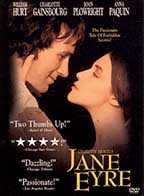 I was in the mood for a good romance. I had seen the 1996 Zeffirelli version of the movie relatively recently. Wrapped up in my blanket, warm drink in hand, I was looking forward to a wonderful midnight viewing of a favourite 19th century novel brought to life on the silver screen on Saturday Night at the Movies on TVO.
I was in the mood for a good romance. I had seen the 1996 Zeffirelli version of the movie relatively recently. Wrapped up in my blanket, warm drink in hand, I was looking forward to a wonderful midnight viewing of a favourite 19th century novel brought to life on the silver screen on Saturday Night at the Movies on TVO.
Somehow, I don’t remember it being so dark and dreary during my previous viewing of the film. Somebody must have thought it was a great idea to use the lighting that would have been present in the original period. Period dress is one thing, but “period lighting”? No one could see a thing running around with candles in that dark and dank old mansion. I kept wanting to go over and adjust the T.V. set so that I could see something.
While it might be true that the original author, Charlotte Brontë, successfully created a dark and forboding atmosphere in her novel, I don’t think that the darkness translates very well into a visual medium where you can’t see much half of the time because the set is too dark. It was more of an annoyance than anything else.
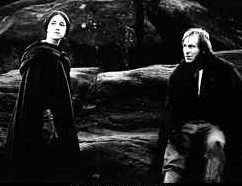 I can’t say that I remember the story line well enough to spot all of the deviations in the film from the original novel. It’s been a while. I certainly remember the large strokes of the plot and the emotional tone of the book, but I am a little fuzzy on some of the details. One thing that I do remember, or at least I think I remember from the novel, is that Mr. Edward Rochester is definitely of a darker appearance than Mr.William Hurt. There is only so far that you can go with William Hurt’s definitively blond look. What the physical appearance leaves wanting has to be filled in by the acting in terms of depicting the dark and stormy Rochester character.
I can’t say that I remember the story line well enough to spot all of the deviations in the film from the original novel. It’s been a while. I certainly remember the large strokes of the plot and the emotional tone of the book, but I am a little fuzzy on some of the details. One thing that I do remember, or at least I think I remember from the novel, is that Mr. Edward Rochester is definitely of a darker appearance than Mr.William Hurt. There is only so far that you can go with William Hurt’s definitively blond look. What the physical appearance leaves wanting has to be filled in by the acting in terms of depicting the dark and stormy Rochester character.
 If William Hurt is not exactly what I had always pictured in terms of a Mr. Rochester, the opposite is true when it comes to Charlotte Gainsbourg as Jane Eyre. Gainsbourg’s physical presence is to me the perfect embodiment of the plain Jane. Gainsbourg has quite the work cut out for her as an actress. The dialogue allowed to her character in the film does not fill in the complexity of emotion and intellectual foment under the surface of her character that comes through in the novel. Jane is habitually a woman of few words. Gainsbourg has to meet the challenge of presenting Jane’s character through means other than the dialogue supplied.
If William Hurt is not exactly what I had always pictured in terms of a Mr. Rochester, the opposite is true when it comes to Charlotte Gainsbourg as Jane Eyre. Gainsbourg’s physical presence is to me the perfect embodiment of the plain Jane. Gainsbourg has quite the work cut out for her as an actress. The dialogue allowed to her character in the film does not fill in the complexity of emotion and intellectual foment under the surface of her character that comes through in the novel. Jane is habitually a woman of few words. Gainsbourg has to meet the challenge of presenting Jane’s character through means other than the dialogue supplied.
One of the things that moved me the most in this film was the depiction of the childhood friendship of Jane with Helen Burns. Helen dies of consumption part way through the film in the midst of the grim conditions of the Lowood boarding school. A piercingly touching exchange takes place between the two young friends the night that Helen dies of consumption. In the darkness, Helen says, “Don’t cry, Jane. You mustn’t cry. We’ll be together again. . . We’ll be together again in heaven forever and always.” Jane expresses doubt. Helen replies, “Don’t you believe it, Jane? You must believe it.You must believe! God will take care of us. Good night, dearest Jane.”
 For one reason or another, the scene struck close to home. Perhaps it was the recent memory of the biographical television series about the talented Brontë family seen on TVO. Charlotte Bronte watched her mother and all of her sisters die tragically young of consumption before she herself was taken at an early age. Perhaps it is anticipation of a similar conversation with a friend of mine who is facing the possibility of an untimely death. My friend presently has no hope of a better afterlife and no assurance of a caring Father watching over her. Perhaps it was my little daughter’s midnight coughing fits from yet another upper respiratory tract infection breaking through the silent night as I watched the film. My little girl has told me recently of both her fears about death (being put into a dark pit) and about her childlike trust in God’s provision of heaven.
For one reason or another, the scene struck close to home. Perhaps it was the recent memory of the biographical television series about the talented Brontë family seen on TVO. Charlotte Bronte watched her mother and all of her sisters die tragically young of consumption before she herself was taken at an early age. Perhaps it is anticipation of a similar conversation with a friend of mine who is facing the possibility of an untimely death. My friend presently has no hope of a better afterlife and no assurance of a caring Father watching over her. Perhaps it was my little daughter’s midnight coughing fits from yet another upper respiratory tract infection breaking through the silent night as I watched the film. My little girl has told me recently of both her fears about death (being put into a dark pit) and about her childlike trust in God’s provision of heaven.
In the film, the emotionally abusive Mr. Bocklehurst is seen as a stiff and puritanical authority figure with a twisted sense of Christian duty in regards to caring for his young charges. He stands in stark contrast to the sympathetic Miss Temple, who becomes a mentor and a model for Jane. One wonders how we are ever supposed to believe that Jane Eyre could ever turn out to be a halfway stable and well-rounded individual given the years of rejection and abuse that she suffers. The presence of Miss Temple at Lowood gives a clue as to how, at least in the author’s mind, Jane could survive the deprivations and still be intact: Miss Temple, upon the moment of Jane’s departure from Lowood, says, “I believe that it is God’s will I am here. I cannot leave.” Grace intervenes in the darkest places and redeems an otherwise hopeless situation.
Miss Temple articulates what appears to be a mantra of Charlotte Brontë’s own personal experiences as a female author in the early part of the 19th century. About the girls at Lowood School, Miss Temple maintains, “But you have all been blessed with intelligence. Intelligence and a proper education will give you independence of spirit. And that is the greatest blessing of all. The only thing that matters in your life is to be in harmony with God.”
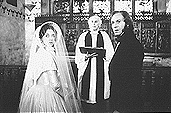 The theme of grace and redemption continues in the main plot as the action moves forward to Thornfield Hall. Rochester asks a basic question about his own potential for redemption. As he is about to ride off to his next diversion from his painful home life, Rochester throws down a challenge before Jane: “Fortune has knocked me about. I once had a heart full of tender feelings. Now I’m as hard and tough as an Indian rubber ball. Think there is any hope for me?”
The theme of grace and redemption continues in the main plot as the action moves forward to Thornfield Hall. Rochester asks a basic question about his own potential for redemption. As he is about to ride off to his next diversion from his painful home life, Rochester throws down a challenge before Jane: “Fortune has knocked me about. I once had a heart full of tender feelings. Now I’m as hard and tough as an Indian rubber ball. Think there is any hope for me?”
One character who appears to be beyond the reach of redemption in the film is Jane’s aunt, Mrs. Reed. On her deathbed, Mrs. Reed remains a soul tortured by her unfair and unreasonably harsh treatment of Jane. The aunt rejects Jane’s offer of forgiveness and reconciliation. Jane’s fortunes eventually change. The aunt steps off the planet into eternity in a state of guilt and alienation. The attempt to make amends has somehow not had a totally beneficial effect. Redemption does not come to everyone.
 Through a maze of complications, Rochester and Jane end up saving each other from a less than ideal situation. Jane, recently elevated in social status, reaches down, and Rochester, mangled by the fickle winds of fortune, reaches up. They meet in the middle and all is right in the world in the end.
Through a maze of complications, Rochester and Jane end up saving each other from a less than ideal situation. Jane, recently elevated in social status, reaches down, and Rochester, mangled by the fickle winds of fortune, reaches up. They meet in the middle and all is right in the world in the end.
It’s an old fashioned romance, with old fashioned heroes and heroines. I love it. It’s a story that couldn’t exist in the modern world. Come to think of it, it didn’t really exist in the world of way back when either, but why not at least entertain the thought? I can think of a lot worse ways to spend a bleak November night.
Further Reading:
- Read the original Brontë novel online.
- "In Search of the Brontës", a TV series shown on TVO reflects the personal story of Charlotte Brontë, also found online in a mini-biography
- .Finding love after growing up in an abusive home.
- Redeeming stories in the movies.
- Miss Temple: "The only thing that matters in your life is to be in harmony with God."
The Canterville Ghost (1944)
Charles Laughton has tremendous fun playing “ The Canterville Ghost” in the wartime adaptation of Oscar Wilde’s classic story.
My brother-in-law called me just after 11pm on Saturday night to tell me that my husband had been hauled into emergency while they were at a family gathering out of town. I was getting ready to watch my TVO movie at the time. My hubby appeared to be okay, although it was a bit of a scare. There wasn’t much that I could do about it sitting at home. I did some research on his presumed condition, and then settled down to watch the late show on Saturday Night at the Movies.
 Under the circumstances, I wasn’t quite ready to go to bed. But I wasn’t ready to scare myself silly either watching pre-Halloween horror movies. The late night flick shown on TVO was just right. I had seen “The Canterville Ghost” before. I knew that it would be just the right mixture of harmless fun and old fashioned patriotism to soothe my jangled nerves. Funny that – watching a late night ghost story to calm your troubled mind.
Under the circumstances, I wasn’t quite ready to go to bed. But I wasn’t ready to scare myself silly either watching pre-Halloween horror movies. The late night flick shown on TVO was just right. I had seen “The Canterville Ghost” before. I knew that it would be just the right mixture of harmless fun and old fashioned patriotism to soothe my jangled nerves. Funny that – watching a late night ghost story to calm your troubled mind.
But sometimes truth is stranger than fiction.
I never knew that Robert Young was so young – at one time. Funny, but I had never pictured him as anything other than the grey haired Marcus Welby, M.D. of my youthful television watching years. But of course he had to have dark hair and a dashing figure at one time or other. Mr. Young was perfectly acceptable as the likeable American G.I., Cuffy Williams. He plays well with children and old farts like Sir Simon de Canterville in his spectral state.
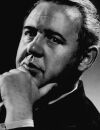 I can’t say that I can plead ignorance to Charles Laughton’s immense comic talent. I think I have seen him in enough films to know that he could be quite the funny fellow. He did seem to relish the role of Sir Simon in this case. What could be better than playing a ghost who does not take himself or his official role of haunting the castle very seriously? Can one possibly imagine a more ludicrous scene for an otherwise very dignified, overstuffed member of the English gentry than to be riding around on top of the “blockbuster bomb” over hill and dale in order to dispose of the dreadful means of mass destruction? My kids weren’t up at the time to watch it, but I am sure they would have gotten a kick out of watching at least that scene and many others.
I can’t say that I can plead ignorance to Charles Laughton’s immense comic talent. I think I have seen him in enough films to know that he could be quite the funny fellow. He did seem to relish the role of Sir Simon in this case. What could be better than playing a ghost who does not take himself or his official role of haunting the castle very seriously? Can one possibly imagine a more ludicrous scene for an otherwise very dignified, overstuffed member of the English gentry than to be riding around on top of the “blockbuster bomb” over hill and dale in order to dispose of the dreadful means of mass destruction? My kids weren’t up at the time to watch it, but I am sure they would have gotten a kick out of watching at least that scene and many others.
I did read some discussion on whether the child star of this film, Margaret O’Brian could be compared with Shirley Temple. To my mind, you can’t really compare the two. Margaret did a good job with this part as the diminutive Lady Jessica de Canterville, but she did not have the star power nor the talent that the young Shirley Temple had. I can’t say that Lady Jessica stole the show, but she did seem to hold her own against a very formidable stage presence (Laughton).
I am sure that I would enjoy immensely the original novella play by Oscar Wilde. I haven’t had the pleasure of reading it. I realize that the 1944 movie version takes great liberties with the original story. As for the fact that the story is reset in WWII England and the American soldiers replace the American millionaire and his family, well, it’s all in good fun. The movie is obviously a vehicle for boosting wartime morale and having the Brits and the Yanks take a few good natured cracks at one another along the way. Having said that, more than fifty years later, the film can still be an amusing ghost story in its own right mainly due, I think, to Laughton’s wonderful talent.
Suggested Reading :
- Read the original Oscar Wilde novella online
- Whatever happened to the innocent childhood fun of Halloween ghost stories?
Frances (1982) and The Elephant Man (1980)
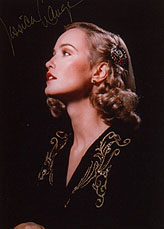 The Beauty in the Beast and the Beast in the Beauty
The Beauty in the Beast and the Beast in the Beauty
Frances Farmer was a sensation. Beautiful and outspoken, the movie actress' troubled personal life and turbulent relationships are depicted in a film that is as controversial as the original media personality. Also based on a true story, the horror of John Merrick's private life as "The Elephant Man" makes for an interesting contrast.
Read the full review here.
Marty (1955)
 An independent film about a working class stiff who navigates dangerous social waters to find love and happiness. Marty is sure a nice fellow and this is sure a nice film to watch again and again.
An independent film about a working class stiff who navigates dangerous social waters to find love and happiness. Marty is sure a nice fellow and this is sure a nice film to watch again and again.
Read the full review here.
Rebel Without a Cause (1955) and September 30, 1955 (1977)
"Live Fast, Die Young"
(attributed to Jimmy Dean)
James Dean's unforgettable performance in "Rebel without a Cause" is memorialized by Richard Thomas in the retrospective look at life in the 1950's, "September 30, 1955". Both movies deal with youth and alienation. Dean's legend lives on in film and in the popular imagination.
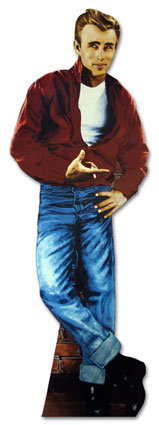 At Dawson College in Montréal on September 13th, 2006, a young man named Kimveer Gill, went on a shooting spree. He killed one young woman, Anastasia DeSousa, and critically injured several others. The gunman killed himself when confronted by police after wounding 19 students at the CEGEP. Gill used a registered gun in the shooting. He had no connection to the school, no recorded history of mental illness, no criminal record. It was apparently a random act of violence. No indicators have been found as to why Gill turned violent. There are no indicators that is, until you read his blog on VampireFreaks.com, a site for young Goths.
At Dawson College in Montréal on September 13th, 2006, a young man named Kimveer Gill, went on a shooting spree. He killed one young woman, Anastasia DeSousa, and critically injured several others. The gunman killed himself when confronted by police after wounding 19 students at the CEGEP. Gill used a registered gun in the shooting. He had no connection to the school, no recorded history of mental illness, no criminal record. It was apparently a random act of violence. No indicators have been found as to why Gill turned violent. There are no indicators that is, until you read his blog on VampireFreaks.com, a site for young Goths.
Gill used the online handle "fatality666". In his posts, he talked about what he had for breakfast, his love life, the violent video games he played, and the fact that he loved guns. Gill’s blog also revealed his sense of profound alienation from and hatred toward the rest of mankind. He also quoted James Dean for an inscription for his tombstone: "Lived fast. Died young. . . ." (See Dean's biography for the real source of the quote)
The two movies shown in past episodes on Saturday Night at the Movies, Rebel Without a Cause and September 30, 1955 look at alienation in youth culture. Jimmy Dean was an icon of rebellious youth. The movies are a retrospective look at how that image was first generated and how the legend was then maintained.
Rebel Without a Cause and September 30, 1955 both have in common the fact that the director wrote the story for the film. Nicholas Ray, Rebel’s director, came up with the story. Ray even did “personal research” by riding around at night with L.A. gangs to get a feel for what was going on. The title was retained from a non-fiction work for which the studio had bought the rights and the story became fictionalized through an adaptation process before being translated for film by a screenwriter.
September 30th is actually a semi-autobiographical story by the director, James Bridges, who becomes the Jimmy J. character (Richard Thomas) in the film. Bridges attempts to capture the atmosphere, the people and the events that related to his own late adolescence including his personal idolization of the actor, James Dean.
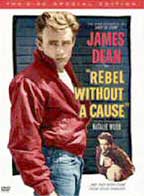 I don’t quite know how to say it, but I was a little disappointed when I first saw Rebel Without a Cause. I found it to be somewhat hokey. I’m not altogether sure why. Maybe I had built up vast expectations in my mind. Maybe the 1950’s psychologizing aspect was too close to sermonizing for my taste. I don’t know. I do know that I appreciated the movie more the second time around.
I don’t quite know how to say it, but I was a little disappointed when I first saw Rebel Without a Cause. I found it to be somewhat hokey. I’m not altogether sure why. Maybe I had built up vast expectations in my mind. Maybe the 1950’s psychologizing aspect was too close to sermonizing for my taste. I don’t know. I do know that I appreciated the movie more the second time around.
For a movie called “Rebel Without a Cause”, the film’s approach devoted much attention to carefully underscoring the “causes for rebellion” in the three main adolescent characters. These being adolescents from middle class suburbia, the existence of teenage rebellion must have seemed like a much more perplexing and indeed troubling phenomenon for parents and society in general in the 1950s. This being an era of unsurpassed peace and prosperity in America, the most obvious culprits are obviously not to blame (poverty, disenfranchisement, war, social upheaval . . .). How could such “nice, normal” middle class kids get involved so quickly in socially maladjusted hooliganism and destructive violence?
It seems to me that in answering these questions, Nicholas Ray goes in a couple of directions. There is the inward exploration through psychological analysis of people and events and there is the upward exploration of the overarching metanarrative.
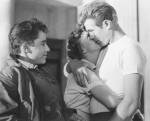 For ‘Plato’, played by Sal Mineo, the blatant neglect and emotional aloofness of his divorced parents emerges as the reason for his disconnect from normal society and ultimately from reality as he descends into fear and paranoia. Plato just wants to belong. He attaches himself to Jim as a friend and a kind of a father figure.
For ‘Plato’, played by Sal Mineo, the blatant neglect and emotional aloofness of his divorced parents emerges as the reason for his disconnect from normal society and ultimately from reality as he descends into fear and paranoia. Plato just wants to belong. He attaches himself to Jim as a friend and a kind of a father figure.
Judy (Natalie Wood) uses her budding sexuality to create meaning and a sense of belonging for herself. Scenes where her father rebuffs her affectionate kisses (“You’re too old for that kind of thing now!” her dad barks) are supposed to “explain” Judy’s involvement in the gang. Since Judy has problems finding validation and acceptance, including acceptance of her emerging sexuality, at home, she finds it elsewhere. She becomes the gang leader’s girlfriend. Later, she experiences “real love” for the first time by belonging to fellow outsider, Jim Stark.
 Jim Stark as realized by Jimmy Dean is a young man who has problems communicating with his parents, people who obviously have problems of their own. Jim uses alcohol to try to cope with his inward confusion and turmoil. His parents use social mobility (moving from town to town) to try to cover up and cope with their son’s problems. Jim’s desperate attempts to try to talk to his parents end in frustration. Jim gives up, blockaded by his mom’s evasion of the truth and steadfast commitment to superficiality and appearances. He finds it impossible to connect with a father who wears an apron and refuses to “stand up” to his wife’s henpecking. Even though they are trying to be good parents, Jim doesn’t find what he needs at home.
Jim Stark as realized by Jimmy Dean is a young man who has problems communicating with his parents, people who obviously have problems of their own. Jim uses alcohol to try to cope with his inward confusion and turmoil. His parents use social mobility (moving from town to town) to try to cover up and cope with their son’s problems. Jim’s desperate attempts to try to talk to his parents end in frustration. Jim gives up, blockaded by his mom’s evasion of the truth and steadfast commitment to superficiality and appearances. He finds it impossible to connect with a father who wears an apron and refuses to “stand up” to his wife’s henpecking. Even though they are trying to be good parents, Jim doesn’t find what he needs at home.
It’s all very Freudian.
And then there is the trip to the planetarium. More than just a mere school outing, the monologue supplied to the high school students about the universe during the presentation at the planetarium also provides the filmmakers with the opportunity to pull out modernism’s reigning metanarrative for inspection. Naturalism’s ultimate answer for “who we really are as human beings and where we fit in in the grand scheme of things” is touted as the great wisdom that modern science has to offer. Kids struggling with issues of personal identity, purpose, and belonging sit in a vast, darkened hall learning that humanity is alone in the universe. A disembodied voice of authority tells them that as to our origins, all is a cosmic accident and that the universe will end long after the human race has exited the scene after its brief and meaningless stay on an insignificant planet. Cold comfort that.
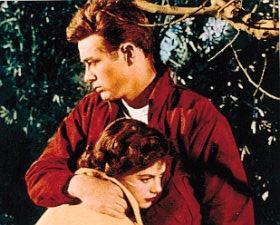 As I said, the second time around with “Rebel”, I enjoyed it more. I was able to focus more on details. There were details like the opening credits with the virtuosity of James Dean’s improv performance with the toy monkey while lying drunk and disorderly on the sidewalk - Details such as the redness of Judy’s coat and matching lipstick that she carefully paints on at the police station. Is Judy making a statement about rebellion through a flaunted sexuality, or is she merely a young girl caught up in the latest fashion trends, or both? Plato’s socks don’t match. So what? The socks become the brunt of a juvenile joke at Plato’s expense. They also reflect the painful state of inner confusion for Plato over everything from who his parents are to who his friends are to who he is (there are hints of Plato’s confusion over his sexual orientation).
As I said, the second time around with “Rebel”, I enjoyed it more. I was able to focus more on details. There were details like the opening credits with the virtuosity of James Dean’s improv performance with the toy monkey while lying drunk and disorderly on the sidewalk - Details such as the redness of Judy’s coat and matching lipstick that she carefully paints on at the police station. Is Judy making a statement about rebellion through a flaunted sexuality, or is she merely a young girl caught up in the latest fashion trends, or both? Plato’s socks don’t match. So what? The socks become the brunt of a juvenile joke at Plato’s expense. They also reflect the painful state of inner confusion for Plato over everything from who his parents are to who his friends are to who he is (there are hints of Plato’s confusion over his sexual orientation).I appreciated more the quality of some of the acting, including that of James Dean. I also appreciated how certain visual aspects were used. Some of Dean’s lines are pitched from a cockeyed camera angle, evoking the skewed and disjointed perspective of the restless teen. The film starts with a claustrophobically close-up shot of Jimmy Dean and the toy monkey on the ground and ends with a wide-angled zoom out of the planetarium from the air. It’s as if you can only take such an intensely scrutinized look at the egocentric world of the teens for so long. Then you have to glance away to a wider viewpoint.
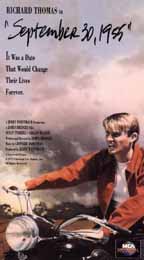 Life lived with intensity and turmoil – That pretty much describes September 30, 1955. It was a film I only saw once and am likely to see only once, given that it is not a particularly famous film. This was another midnight movie where I kept saying to myself, “Now be reasonable, self. You just have to get to bed!” Thank goodness that I decided not to listen to the Voice of Reason. I might have missed a very compelling performance by Richard Thomas and a very interesting take on youth culture as it existed in the 1950’s.
Life lived with intensity and turmoil – That pretty much describes September 30, 1955. It was a film I only saw once and am likely to see only once, given that it is not a particularly famous film. This was another midnight movie where I kept saying to myself, “Now be reasonable, self. You just have to get to bed!” Thank goodness that I decided not to listen to the Voice of Reason. I might have missed a very compelling performance by Richard Thomas and a very interesting take on youth culture as it existed in the 1950’s.
The “Leave it to Beaver” mentality had definitely left the studio lot by the time this film was shot in 1977. James Bridges gives us a fair and honest treatment of issues affecting teens: social conformity and individual independence, social acceptance and social rejection, experimentation with sex and lots of confusion surrounding sex, the collision of idealism and reality, communication and the generation gap. Bridges shows us that, unlike the world we saw in “Leave it to Beaver”, all that stuff was there in the 1950’s just as it is there today.
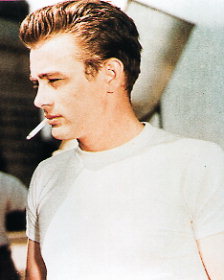 Jimmy J. is passionately caught up with the idea of going out to Hollywood to somehow connect with his dead idol, James Dean. Jimmy J.’s encounter with the onscreen Dean has been a revelation that somehow gives voice to his passions and meaning to his life. Dean is a hero for Jimmy, “someone who has changed my life”. Jimmy J. says, “My life is starting to feel like a movie. Nothing is real, but it (“Rebel”?) is more real than a movie.” B. J. replies, “This isn’t a movie.” Jimmy J. eventually rides off into the sunset on his new motorcycle with his red jacket in search of a new life in the steps of his hero, Jimmy Dean.
Jimmy J. is passionately caught up with the idea of going out to Hollywood to somehow connect with his dead idol, James Dean. Jimmy J.’s encounter with the onscreen Dean has been a revelation that somehow gives voice to his passions and meaning to his life. Dean is a hero for Jimmy, “someone who has changed my life”. Jimmy J. says, “My life is starting to feel like a movie. Nothing is real, but it (“Rebel”?) is more real than a movie.” B. J. replies, “This isn’t a movie.” Jimmy J. eventually rides off into the sunset on his new motorcycle with his red jacket in search of a new life in the steps of his hero, Jimmy Dean.
Youth and alienation are nothing new. Perhaps the role of the Internet and the accessibility of high powered guns were not present in 1955, but otherwise it is amazing to see how the same themes work themselves out in the onscreen tragedies of yesteryear and the real life tragedies of today's headlines.
One Blair Hagen, spokesman for the National Firearms Association, was quoted in the newspaper as saying, “I think it (the shooting at Dawson College) demonstrates that gun control has absolutely no effect. When you have a person like this who has hate in his heart, regulations and registries are not going to stand in his way.” Well, yes and no. I still think that making some co-coordinated attempt at controlling the flow of firearms is the only rational way for a civilized and democratic society to proceed in averting a culture of violence. And yes, the only way to keep people like Kimveer Gill from destroying lives is to deal successfully with the issues of the heart.
Suggested Reading:
- James Dean learned to fight with a switchblade from a cast member who was a former Hollywood street gang member. Dean and Allen (Buzz) used real switchblades during the on camera knife fight and wore chain mail under their clothes to protect themselves. Trivia from IMDb
- "Lived fast, lives on to tell about it . . . " a story of redemption : Chrisitan Hosoi - from pro skateboarding champion, to crystal meth, to prison, to freedom (video)
- "Excuse me, people . . . Could we get an alternative metanarrative in here and see how that fits? Maybe if we tried that shot from a different angle . . . "
- Astrology, the way of power and the enlightened masters: Finding the deeper truths of life



